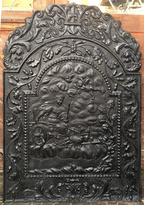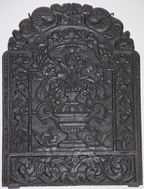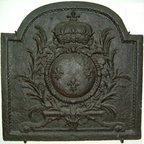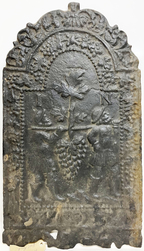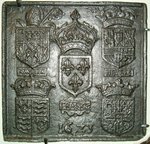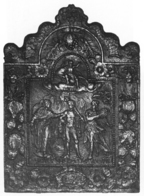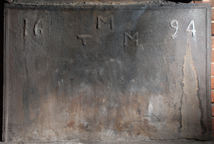-
1059
Description: Arched rectangular central panel with bead on broad fillet edging; pictorial scene of a figure in a chariot on left, drawn across clouds by two peacocks; above, a putto and a bird flying in clouds; to the right, a tree; arched rectangular border with fillet edging; symmetrical undulating oak fronds descending from a loop; at the bottom, the letter W in a cartouche between swirled foliage; on top, mirrored swirled foliage descending from a loop.
Notes: The figure is likely to be that of Hera/Juno, who is traditionally associated with peacocks. The initial 'W' probably identifies the pattern maker; a single vertical line right of centre indicates the join between two boards that formed the pattern. The 'W' initial probably denotes the pattern maker.
Inscription: W
- Decoration tags:
- 'Dutch' (shape)
- fillet (edging)
- whole carved pattern
- planklines
- pictorial
- allegorical
- text
- humans
- plants
- objects
Manufactured: in the late-17th to early-18th century in England.
Current location: not known.
- Attached to series:
- British 'Dutch' style firebacks
- W series
-
726
Description: Arched rectangular central panel with bead-on-fillet edging; pictorisl scene of a central cross-shaped pillar entwined with a snake; two pavilions to the left with human figures lying before them; two standing figures to the right, one holding a staff; above, clouds with snakes descending from the sky; arched rectangular border with fillet edging; on each side, descending festoons of fruit entwined with ribbon; at the bottom, a central cartouche between palm fronds; on top, foliate swirls.
Notes: The scene is an illustration of the plague of serpents visited upon the children of Israel by God (Numbers 21: 6).
Copies of this fireback are known.
Manufactured: in the mid-17th century possibly in the Siegerland area of Germany.
Current location: Victoria & Albert Museum, Cromwell Road, Kensington & Chelsea, Greater London, England.
Museum number: 291-1893 (part of the Victoria & Albert Museum museum group)
Citation: Anon., 2 Dec 1905, 'Old Kent and Sussex Fire-backs', Country Life, pp. 767-768.
- Attached to series:
- 'Dutch' Miscellaneous Firebacks
- Old Testament & Apocrypha firebacks
-
747
Description: Arch-shaped; fillet edge; Tudor shield, crown, garter (motto clockwise but reversed) and supporters. Crowned rose on dexter, and crowned portcullis (grid of 16) on sinister side of crown; the supporters, a dragon and a greyhound, stand on separate plinths; the initials, G P are placed in either side of the garter buckle.
Notes: There are several firebacks with the Tudor royal arms that were probably originally produced in the Spanish Netherlands, perhaps illustrating the association between England and Spain through the marriage of Henry VIII and Katherine of Aragon. The firebacks differ in several small details, such as the form and rotation of the Garter motto, the style of the crown, the positioning of the supporters in relation to the Garter, and the form and size of the crowned rose and portcullis. Part of the bequest to the Victoria and Albert Museum by Lieut. Colonel G. B. Croft-Lyons in 1926.
Inscription: HONY SOYT QVI MAL Y PENSE / G P
Arms: Tudor royal
- Decoration tags:
- rounded arched (shape)
- fillet (edging)
- whole carved pattern
- heraldic
- armorial
- royal
- text
Manufactured: in the mid-16th century possibly in the Wallonia area of Luxemburg.
Current location: Victoria & Albert Museum, Cromwell Road, Kensington & Chelsea, Greater London, England.
Museum number: M.499-1926 (part of the Victoria & Albert Museum museum group)
- Attached to series:
- Tudor royal armorial firebacks
- Continental Tudor royal armorial firebacks
-
755
Description: Arched rectangular central panel with bead-and-pellet edging; on a ground between two plants, a fluted flower vase with two, scrolled handles, tulips and other flowers issuing from the narrow neck; arched rectangular border with fillet edging; mirrored descending flower swags; along a rectangular bottom panel with fillet edging a symmetrical arrangement of swirled foliage; narrow, curved shouldered side panels with beads in oval depressions; on top, two mirrored sea serpents.
Notes: The presence of tulips suggest a Dutch origin for the pattern of this fireback, although the presence of several examples in England suggest that it was produced here rather than on the Continent; this is the smaller of two versions of this fireback.
Copies of this fireback are known.
- Decoration tags:
- 'Dutch' (shape)
- fillet (edging)
- whole carved pattern
- extension panels
- pictorial
- plants
- objects
Manufactured: in the late-17th century in England.
Current location: Victoria & Albert Museum, Cromwell Road, Kensington & Chelsea, Greater London, England.
Museum number: 41.1896 (part of the Victoria & Albert Museum museum group)
- Attached to series:
- British 'Dutch' style firebacks
- Flower Vase 'Dutch' types
-
765
Description: Arched rectangular; fillet edging with darts on the inside; circular arms of France within the chains of the Ordre d'Esprit and the Ordre de St Michel, with crown above, all resting on a framework compartment, with olive leaf sprays on each side ofn the shield.
Notes: Typical form of the arms of France of the period of Louis XIV.
Arms: France modern
- Decoration tags:
- rectangular with round arch (shape)
- fillet (edging)
- whole carved pattern
- armorial
- royal
Manufactured: in the late-17th to early-18th century in France.
Current location: Victoria & Albert Museum, Cromwell Road, Kensington & Chelsea, Greater London, England.
Museum number: M.1132-1926 (part of the Victoria & Albert Museum museum group)
Citation: Carpentier, H., 1912, Plaques de Cheminées (Paris, published by the author).
- Attached to series:
- Foreign armorial firebacks
-
1274
Description: Arched rectangular central panel with bead edging; image of two helmeted men in 17th century dress, on a ground, carrying a huge bunch of grapes slung from a pole between them, behind are vine leaves; the initials located below the top corners; arched rectangular border, fillet edging, containing vine leaves and grapes; above, symmetrical swirling foliage descending from a scallop shell; bottom of the image obscured by corrosion damage.
Notes: The scene, drawn from the Old Testament, represents Joshua and Caleb carrying the bunch of grapes from the valley of Eshcol in the land of Canaan, back to Moses and the children of Israel (Numbers 13: 23-4); a popular subject on a variety of media in the period.
Inscription: I N
Manufactured: in the mid- to late-17th century possibly in the Siegerland area of Germany.
Current location: Victoria and Albert Museum, Cromwell Road, Kensington and Chelsea, London, England.
Museum number: M.372-1912 (part of the Victoria & Albert Museum museum group)
- Attached to series:
- Joshua and Caleb firebacks
- Old Testament & Apocrypha firebacks
-
1171
Description: Rectangular shape; fillet edging; arrangement of five shields: centre, arms of the kingdom of France surmounted by a crown and, below, the word FRANCE on a fillet edged rectangular block over a cartouche; top left, arms of the duchy of Lorraine surmounted by a bishop's mitre and crozier separating a largely illegible text; top right, arms of the kingdom of Spain surmounted by a crown with the letters SPA to the left; bottom right, arms of the duchy of Nevers surmounted by a coronet below a fillet edged rectangle with the word NEVERS; bottom left, arms of the kingdom of England surmounted by a crown below a fillet edged rectangle with the word ANGLIA; bottom centre, the date 1623.
Notes: A taque de foyer or takenplatte; the arms in the corners are likely to be of (from top left): Louis III of Lorraine, Archbishop of Reims; King Philip III of Spain; Charles I, Duke of Nevers and Rethel; and Queen Elizabeth I of England. A similar fireback with the same arms, illustrated by von den Driesch (1990, p.181), has the date 1611, but the absence of a cardinal's hat over the arms of Louis of Lorraine suggests that the fireback originally dates from before 1605.
Inscription: [LORR]AI[NE] SPA / ANGLIA NEVERS / FRANCE / 16z3
Arms: Louis of Lorraine; Kingdom of Spain; Kingdom of France; Kingdom of England; Charles Gonzaga, Duke of Nevers
- Decoration tags:
- rectangular (shape)
- fillet (edging)
- whole carved pattern
- individual numbers
- heraldic
- armorial
- royal
- text
Manufactured: in 1623 possibly in the Ardennes area of Belgium.
Current location: Musée Gaumais, 38 Rue d'Arlon, Virton, Luxembourg, Belgium.
(part of the Musée Gaumais, Virton museum group)
- Attached to series:
- Foreign armorial firebacks
-
1273
Description: Arched rectangular central panel with bead on fillet edging, pictorial scene of Hercules standing, right arm akimbo and left hand holding a club that rests on his shoulder; to his right the allegorical female figure of Virtue, clothed and resting her left hand on Hercules's right shoulder; to his left the female allegorical figure of Volupta, the pair symbolising the 'crossroads' where Hercules has to decide which path in life to take; below them the text VIRTUS HERCULES VOLUPTA; above, seated above clouds, Jupiter surveys the scene, the word IVPITER below; arched rectangular border with fillet edging, from a central bunch of grapes at the top of the arch, a ribbon on each side suspends bunches of fruit and flowers; at the bottom a central cartouche containing the inscription 'L7G', with flowers on each side;; on top are two mirrored dolphins, their tails covering a bunch of grapes.
Notes: The pictorial scene is loosely based on The Judgement of Hercules, c.1636-7, by Nicholas Poussin. The inscription at the bottom indicates the style of border; other firebacks with the same inscription have the same border; similar inscriptions (e.g. L6C and L8G) indicate different borders. Image from von den Driesch (p. 512).
Copies of this fireback are known.
Inscription: IVPITER / VIRTVS HERCVLES VOLVPTA / L7C
- Decoration tags:
- 'Dutch' (shape)
- fillet (edging)
- whole carved pattern
- pictorial
- mythological
- allegorical
- text
- humans
Manufactured: in the mid- to late-17th century in the Siegerland area of Germany.
Current location: not known.
- Attached to series:
- 'Dutch' LC/G series
-
991
Description: Rectangular with fillet edging (top and sides) formed from separate strips, possible from furniture; date split by letters in triad; number '1' has a central knob.
Notes: The initials are believed to relate to Thomas and Mary Manser, who occupied the Star Inn, Waldron, East Sussex, in the seventeenth century.
Inscription: 16 TMM 94
- Decoration tags:
- rectangular (shape)
- fillet (edging)
- simple stamps
- carved stamps
- text
Manufactured: in 1694 in the Weald area of England.
Current location: The Star Inn, Waldron, East Sussex, England.
- Attached to series:
- Date & initials firebacks
-
1159
Description: Arched rectangular shaped central panel, nut-shell on fillet edging, narrow-necked vase on a ground, with flowers and pea pods issuing therefrom, a plant in a pot to each side; arched rectangular shaped border with fillet edging and descending quasi-symmetrical floral tendrils; on top, quasi-symmetrical swirled foliage; date split between bottom corners, with two looped 'W' figures between. A single plankline is evident to right of centre.
Notes: The fourth largest of six flower vase designs on a discrete series of firebacks from 1724. All incorporate the looped 'W' motif which may be intended to identify the pattern maker.
Inscription: 17 24
- Decoration tags:
- 'Dutch' (shape)
- fillet (edging)
- whole carved pattern
- planklines
- pictorial
- text
- plants
- objects
Manufactured: in 1724 in England.
Current location: not known.
- Attached to series:
- 1724 series
- British 'Dutch' style firebacks
